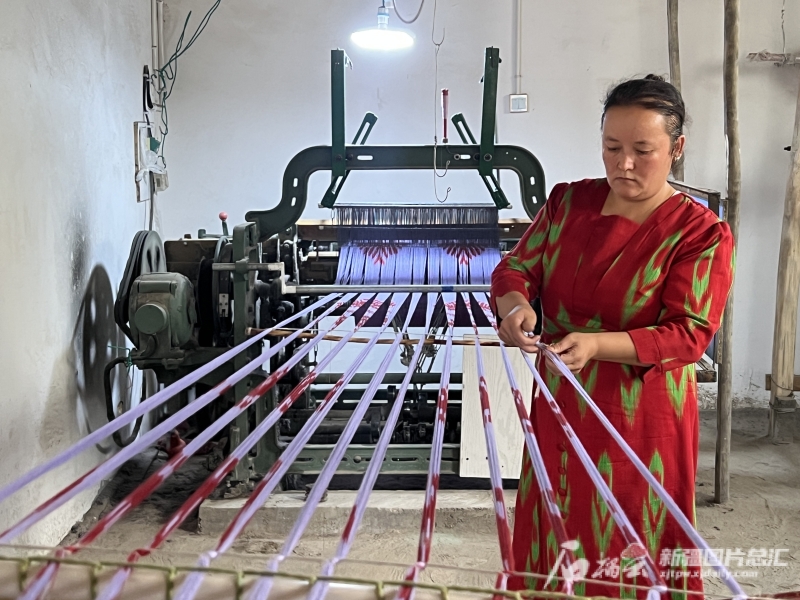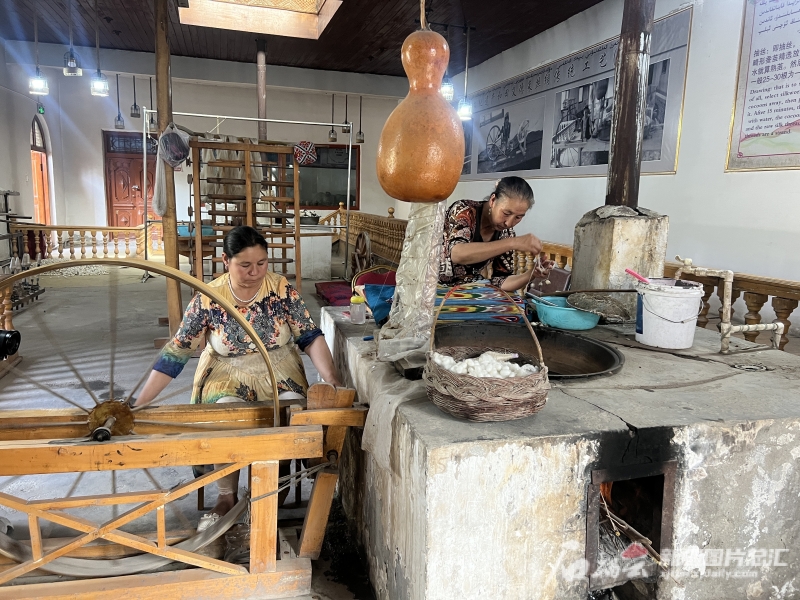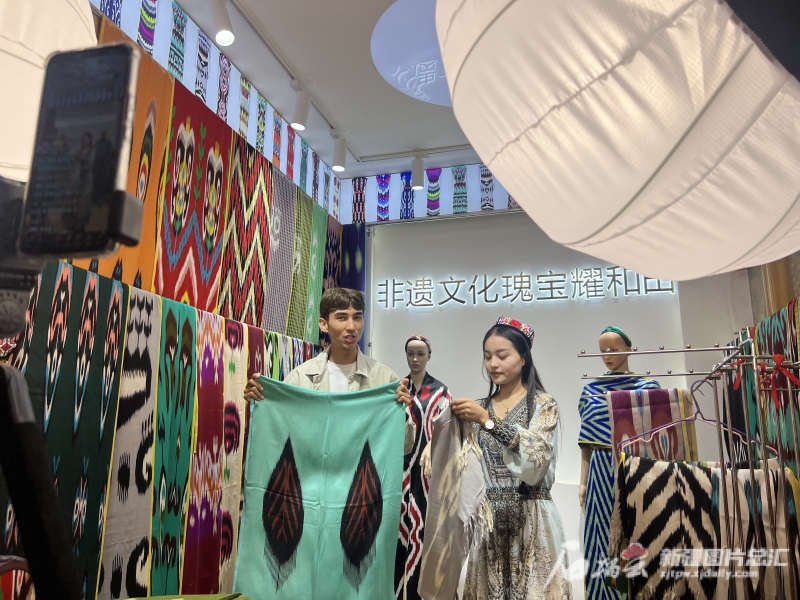Shiliuyun-Xinjiang Daily (Reporter Parizat Abdu) news: Waking up by the sound of “da da” on the morning of September 7, 2023, you could notice a woman standing in front of a weaving machine in Azinaibazha Village, Jiya Township, Hotan City, Hotan Prefecture, northwest China's Xinjiang Uygur Autonomous Region. As Tunsahan Turdi tightened the cloth and adjusted the silk yarns, the colorful silk yarns and the cloth tightly intertwined, becoming the magnificent Atlas silk.

Photo taken on September 7, 2023, shows the villager, whose name is Tunsahan Turdi , weaves the Atlas Silk in Azinaibazha Village, Jiya Township, Hotan City, Hotan Prefecture, northwest China's Xinjiang Uygur Autonomous Region. (Photo by Parizat Abdu)
At first, Tunsahan learned the art of weaving Atlas silk from her husband. It has been 8 years since she has been weaving independently. “Silk yarns are all provided by enterprises which will collect the Atlas silk weaved by us. We now have three weaving machines, which can weave over 780 meters of Atlas silk every month, bringing an income of over 6000 yuan,” said Tunsahan.
The enterprise mentioned by her is Jiyaliren Atlas Silk Co., Ltd. (hereinafter referred to as the company Jiyaliren), which is the largest production base of Atlas silk in the local area.

Photo taken on September 7, 2023, shows Sudihan Abdurehim reels off raw silk from cocoons beside the kitchen range in the workshop of the Jiyaliren Atlas Silk Co, Ltd., in Hotan City, Hotan Prefecture, northwest China's Xinjiang Uygur Autonomous Region. (Photo by Parizat Abdu)
In a workshop of the company, Sudihan Abdurehim, dressed in an Atlas silk dress, sat cross legged by an old-fashioned kitchen range. She first stirred the cocoons in the pot with a wooden stick, then picked them up and slowly spun them. In the printing and dyeing workshop, Ablat Mattursun, sitting on the top of a kitchen range that filled with dye, had been rotating the scroll for 30 minutes. The snow-white silk yarns was turned into dark brown ones. In the weaving workshop, Nurmamat Ahmat, who has been weaving Atlas silk for 51 years, lowered his head slightly, skillfully swung the shuttle, stepped on the pedal. The next thing you saw was the exquisite Atlas silk. This is the normalcy of life here in the company.

Photo taken on September 7, 2023, shows Ablat Mattursun dyes silk yarn in the workshop of the Jiyaliren Atlas Silk Co, Ltd., in Hotan City, Hotan Prefecture, northwest China's Xinjiang Uygur Autonomous Region. (Photo by Parizat Abdu)
Since its establishment in 1997, the company has always been the loyal inheritor of the traditional craft of hand weaving Atlas silk, which has driven employment for 150 people. Mamatali Rozimamat, the head of the company, told reporter that he is the seventh generation inheritor of Atlas silk production. Traditionally, a handmade Atlas silk requires processes such as cocoon cooking, reeling, dyeing, and weaving, which takes a month for one person to make. Nowadays, with modern weaving machines, processes are way more efficient and faster with specialized personnel for each process, thus increasing sales volume.
In 2008, the traditional Atlas silk production process was inscribed in the list of State-level intangible cultural heritage items of China. From then on, how to integrate traditional craftsmanship with modernity has become a topic that the company has been exploring. “The company has set up a research and development team, which now develops three different patterns and colors of Atlas silk every month. In August this year, we began to sell Atlas silk on Douyin, the Chinese version of TikTok, through livestreaming. Just two days ago, we participated in an exhibition of intangible cultural heritage, and got an order worth more than 300,000 yuan,” said Mamatali. The company has developed and produced 18 products with Atlas silk, including scarves, ties, wallets, sunhats, handbags, backpacks, pillows, and so on.

Photo taken on September 7, 2023, shows livestreamers introduce the Atlas scarf in the Jiyaliren Atlas Silk Co, Ltd., in Hotan City, Hotan Prefecture, northwest China's Xinjiang Uygur Autonomous Region. (Photo by Parizat Abdu)
The company now owns workshops respectively for reeling, dyeing, preparing material, weaving, an exhibition hall, and a tailor service center, with an annual production of 30,000 pieces of Atlas silk series products. In the first half of this year, it received 400,000 tourists and achieved a sales revenue of over 2.5 million yuan.
“As the birthplace of Atlas silk, Jiya Township is known as the ‘home of Atlas silk’,” said Arzugvl Ablat, deputy chief of Jiya Township. It was told that there are currently 7 enterprises, 4 cooperatives, 668 households that produce Atlas silk, and 765 weaving machines in the township. The Atlas silk industry has achieved a complete industrial chain from reeling, dyeing, weaving to selling. In 2022, the production value of Atlas silk exceeded 30 million yuan.
In June, 2023, Wali Abdullah, a villager from Atlas Village in Jiya Township, was the first to register after learning about the village's decision of raising silkworms at farmers' homes. The whole family knows how to weave Atlas silk, and they have also raised silkworms using mulberry leaves before. He learned that this time they would raise silkworms with all-purpose feed. He decided to give it a try.
“The silkworms start spinning silk now, and the cocoons will also be collected by enterprises. This time, I have raised 10 boxes of silkworms, and based on the current market price of 50 yuan per kilogram of cocoons, the monthly income can reach over 4000 yuan,” Wali said happily.
Arzugvl introduced that the village has adopted the mode of integrating the Party branch, enterprises, scientific research institutes, and farmers since June this year. Farmers are suggested using all-purpose feed to raise silkworms, which was a great success. In addition, 2100 mu of mulberry trees are planted in the entire township, laying the foundation for completing the Atlas silk industry chain. "In the future, we will build drying houses and silkworm houses to further power the silkworm industry in order to achieve large-scale and intensive development and connect the entire Atlas silk industry chain, thus helping more farmers increase their income, " she said.
(A written permission shall be obtained for reprinting, excerpting, copying and mirroring of the contents published on this website. Unauthorized aforementioned act shall be deemed an infringement, of which the actor shall be held accountable under the law.)









